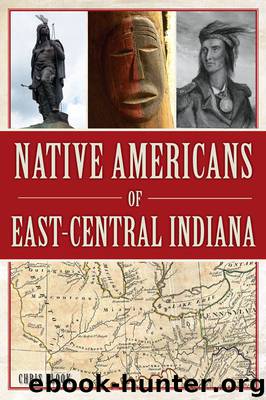Native Americans of East-Central Indiana (American Heritage) by Flook Chris

Author:Flook, Chris [Flook, Chris]
Language: eng
Format: epub
Publisher: Arcadia Publishing Inc.
Published: 2016-06-05T16:00:00+00:00
THE MORAVIAN MISSIONS AND LENAPE
INFLUENCE ON PONTIAC
Throughout the eighteenth century, the Moravian Christians made several attempts to convert Lenape bands to Christianity. Often traveling with them as they relocated west, Moravians established missions among the Lenape in present-day Pennsylvania, Ohio and Indiana. Largely led by the efforts of David Zeisberger, the Moravians made strong inroads in converting Northern Unami and some Munsee speakers between the middle of the 1700s until the American Revolution. Zeisberger was well liked, having been adopted into the tribe in order to possess an influential seat on the Lupwaaeenóáuk. 236 Zeisberger’s writings and observations have assisted in providing modern historians with a better understanding of the Lenape in the eighteenth century. Moravian missions were located throughout Pennsylvania Colony, and by the time of the American Revolution, several missions of Christian Lenape were located near present-day Coshocton, Ohio, at Gnadenhütten, Schoenbrunn, Salem and Lichtenau. A mission at Goshen, Ohio, was founded in 1798.
The Moravian missionaries were not entirely welcomed by all Lenape, an attitude that became more pronounced after the American Revolution. Disease and warfare continually played a part in keeping certain factions divided over issues of allegiance and religion; converts “fell under suspicion as a faction of Delawares disagreed with those who thought an association with the Moravians could help their people.” 237 A series of Lenape “prophets” emerged at this time, urging followers to return to traditional ways of life. These prophets inaugurated nativist movements, with a message that “was clearly anti-white,” 238 blending various traditions. The “nativist revival may be interpreted not as an outgrowth of indigenous tradition, but rather as a basically European innovation expressed in native idiom.” 239 The philologist Ray Whritenour added that these movements were “both a reactionary response to European religion and a revival of traditional forms of worship,” 240 a reflection of how both cultures influenced each other and modified their religious practices. This syncretic movement lasted through the later 1700s into the early 1800s and was centrally unorganized. 241
One of the first prominent Lenape prophets was Neolin. In 1761, Neolin’s visions compelled him to teach “the Indian had lost his ‘avenue’ to heaven by allowing the white man into his country and by adopting the white man’s ways.” 242 Neolin advocated for a return to traditional ways of living, foregoing trade with Europeans, alcohol, guns and a general refusal to “co-operate with white traders.” 243 Neolin’s teachings influenced many Lenape and other Native groups in the Ohio country, including Pontiac. Neolin was quite influential on Pontiac in the latter’s rebellion. 244 While not all Lenape took part in Pontiac’s Rebellion, many warriors were found with those who attacked the British. Around this same time, many bands moved west of Fort Pitt, into the present-day state of Ohio. 245 By the time of the American Revolution, Lenape groups had spread across Pennsylvania, New York and Ohio, with remnants still in New Jersey. The main body, consisting of both Munsee and Unami speakers, moved to the Tuscarawas River Valley, west of modern-day Pittsburgh at the present city of Coshocton, known to the Lenape as Koshaxkink.
Download
This site does not store any files on its server. We only index and link to content provided by other sites. Please contact the content providers to delete copyright contents if any and email us, we'll remove relevant links or contents immediately.
Shoot Sexy by Ryan Armbrust(17558)
Portrait Mastery in Black & White: Learn the Signature Style of a Legendary Photographer by Tim Kelly(16873)
Adobe Camera Raw For Digital Photographers Only by Rob Sheppard(16797)
Photographically Speaking: A Deeper Look at Creating Stronger Images (Eva Spring's Library) by David duChemin(16501)
Bombshells: Glamour Girls of a Lifetime by Sullivan Steve(13687)
Art Nude Photography Explained: How to Photograph and Understand Great Art Nude Images by Simon Walden(12853)
Perfect Rhythm by Jae(5074)
Pillow Thoughts by Courtney Peppernell(4016)
The Book of Joy by Dalai Lama(3700)
Good by S. Walden(3348)
The Pixar Touch by David A. Price(3211)
A Dictionary of Sociology by Unknown(2858)
Fantastic Beasts: The Crimes of Grindelwald by J. K. Rowling(2844)
Humans of New York by Brandon Stanton(2690)
Stacked Decks by The Rotenberg Collection(2689)
Read This If You Want to Take Great Photographs by Carroll Henry(2603)
On Photography by Susan Sontag(2487)
Photographic Guide to the Birds of Indonesia by Strange Morten;(2408)
Insomniac City by Bill Hayes(2399)
